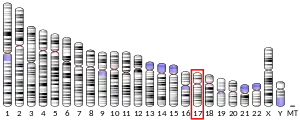| KRT41P | |||||||||||||||||||||||||||||||||||||||||||||||||||
|---|---|---|---|---|---|---|---|---|---|---|---|---|---|---|---|---|---|---|---|---|---|---|---|---|---|---|---|---|---|---|---|---|---|---|---|---|---|---|---|---|---|---|---|---|---|---|---|---|---|---|---|
| Identifiers | |||||||||||||||||||||||||||||||||||||||||||||||||||
| Aliases | KRT41P, hHaA, phihHaA, KRTHAP1, keratin 41 pseudogene, keratin 41, pseudogene | ||||||||||||||||||||||||||||||||||||||||||||||||||
| External IDs | GeneCards: KRT41P | ||||||||||||||||||||||||||||||||||||||||||||||||||
| |||||||||||||||||||||||||||||||||||||||||||||||||||
| |||||||||||||||||||||||||||||||||||||||||||||||||||
| Wikidata | |||||||||||||||||||||||||||||||||||||||||||||||||||
| |||||||||||||||||||||||||||||||||||||||||||||||||||
KRT41P,[3] formerly KRTHAP1 (also known as ΨhHaA, h prefix for "human") is a human pseudogene that used to code for a keratin. It is believed to be responsible for fur-like body hair.[4]
There is still variation in the degree of body hair among human beings and occasional examples have been found of people where the gene is active leading to very thick body hair as a result. Although the mutation was dated to 240 000 by Winter et al., it is also present in the Vindija Neandertal and Altai Denisovan sequences. Hence the dating must be older than 700 00 kya and possibly more than 1 mya considering the latter's divergence date. Given the divergence of pubic and head hair lice, the date of the mutation may be as old as 3.3 million years old.[4]
References
- 1 2 3 GRCh38: Ensembl release 89: ENSG00000225438 - Ensembl, May 2017
- ↑ "Human PubMed Reference:". National Center for Biotechnology Information, U.S. National Library of Medicine.
- ↑ "KRT41P Gene - Keratin 41, Pseudogene". Genecards.org.
- 1 2 Winter, H.; Langbein, L.; Krawczak, M.; Cooper, D. N.; Jave-Suarez, L. F.; Rogers, M. A.; Praetzel, S.; Heidt, P. J.; Schweizer, J. (2001). "Human type I hair keratin pseudogene phihHaA has functional orthologs in the chimpanzee and gorilla: Evidence for recent inactivation of the human gene after the Pan-Homo divergence". Human Genetics. 108 (1): 37–42. doi:10.1007/s004390000439. PMID 11214905. S2CID 21545865.

